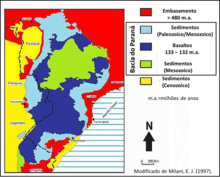Botucatu Formation
The Botucatu Formation is an Aptian geologic formation of the Paraná and Pelotas Basins in southern Brazil and northern Uruguay. The formation is composed of quartzitic sandstones, deposited in an eolian environment.[1] Fossil theropod tracks have been reported from the formation.[2]
| Botucatu Formation Stratigraphic range: Aptian | |
|---|---|
| Type | Geological formation |
| Unit of | São Bento Group |
| Underlies | Serra Geral Formation |
| Overlies | Rio do Rasto Formation |
| Lithology | |
| Primary | Sandstone |
| Location | |
| Coordinates | 29.7°S 52.4°W |
| Approximate paleocoordinates | 30.6°S 19.5°W |
| Region | Rio Grande do Sul |
| Country | |
| Extent | Paraná & Pelotas Basins |
| Type section | |
| Named for | Botucatu |
 Geologic map of the Paraná Basin with the Paleozoic and Mesozoic units in light blue | |
Description
The sandstone is fine-textured and well sorted, containing no pebbles; its colour is occasionally white, yellowish, and reddish, but more commonly it is pinkish. Nearly always it is silicified and therefore compact and hard.[3] The formation was deposited in an arid desert environment, characterized by sabkhas and wadis.[4]
Fossil content
Among the following fossils were reported from the Botucatu Formation:[3]
- Coelurosauria indet.
- Lacertilia indet.
- Mammalia indet.
- Ornithopoda indet.
- Theropoda indet.
- Vespersaurus
- ?Tritylodontoidea indet.
- Brasilichnium elusivum[4]
gollark: I mean, not really,
gollark: Pseudobasicode?
gollark: > talks about fancy computer-science stuff> uses some weird horrible BASICy language
gollark: Try what?
gollark: Idea: use linux.
See also
- List of dinosaur-bearing rock formations
- List of fossiliferous stratigraphic units in Uruguay
- Itapecuru Formation, contemporaneous fossiliferous formation of the São Luis and Parnaíba Basins
- Bahia Group, contemporaneous fossiliferous formation of the Recôncavo Basin
- Quiricó Formation, contemporaneous fossiliferous formation of the São Francisco Basin
- La Cruz Formation, contemporaneous fossiliferous formation of the Marayes-El Carrizal Basin, Argentina
- Rayoso Formation, contemporaneous fossiliferous formation of the Neuquén Basin, Argentina
- Cerro Barcino Formation, contemporaneous fossiliferous formation of the Cañadón Asfalto Basin, Argentina
- Río Belgrano Formation, contemporaneous fossiliferous formation of the Austral Basin, Argentina
References
- Petrolli & Pimentel, 2014, p.1
- Weishampel, et al. (2004). "Dinosaur distribution." Pp. 517-607.
- São Bento quarry, Araraquara at Fossilworks.org
- Leonardi, 1994, p.50
Bibliography
- Leonardi, Giuseppe. 1994. Annotated Atlas of South America Tetrapod Footprints (Devonian to Holocene) with an appendix on Mexico and Central America, 1–248. Ministerio de Minas e Energia - Companhia de Pesquisa de Recursos Minerais, Geological Service of Brazil. Accessed 2019-03-25.
- Petrolli, Larissa, and Ana Maria Pimentel Mizusaki. 2014. Formação Botucatu (Jurássico, Bacia do Paraná) – análogo como reservatório de hidrocarbonetos para as bacias da margem continental brasileira, 1. Universidade Federal do Rio Grande do Sul. Accessed 2017-09-09.
- Weishampel, David B.; Peter Dodson, and Halszka Osmólska (eds.). 2004. The Dinosauria, 2nd edition, 1–880. Berkeley: University of California Press. Accessed 2019-02-21.ISBN 0-520-24209-2
Further reading
- Leonardi, G. 1989. Inventory and statistics of the South American dinosaurian ichnofauna and its paleobiological interpretation. In D. D. Gillette & M. G. Lockley (ed.), Dinosaur Tracks and Traces 165-178.
- Leonardi, G. 1980. On the discovery of an abundant ichno-fauna (vertebrates and invertebrates) in the Botucatu Formation s.s. in Araraquara, São Paulo, Brazil. Anais da Academia Brasileira de Ciências 52(3):559-567 link.
- Leonardi,G., Carvalho, I.S., and Fernandes, M.A. 2007. The desert ichnofauna from Botucatu Formation (Upper Jurassic–Lower Cretaceous), Brazil. In: Carvalho, I.S., Cassab, R.C.T., Schwanke, C.,Carvalho, M.A., Fernandes, A.C.S., Rodrigues, M.A.C., Carvalho, M.S.S., Arai, M., and Oliveira, M.E.Q. (eds.). Paleontologia: Cenários da Vida, I. Interciência, Rio de Janeiro, Brazil. p, 372–383. link.
This article is issued from Wikipedia. The text is licensed under Creative Commons - Attribution - Sharealike. Additional terms may apply for the media files.